
Once a year on Christmas Island, in the Indian Ocean, some 120 million terrestrial crabs migrate from the jungle to the water to breed. The crabs swarm during the rainy season, which takes place between October and December. When the air is moist, the crabs are able to complete the 5-7 day trip without dying from dehydration.
The crabs mate on the beach in small holes in the sand, then the males return to the rainforest while the females produce eggs. The eggs are then carried to the water’s edge to coincide with the turning of the tide, the female releasing their eggs when the difference between ebb and flow is the least.
The eggs hatch immediately they come into contact with water, the small crabs developing in the ocean over a period of about one month, until they are 5mm wide. They then move back onto shore and begin a nine-day march back towards the rainforest.
As the crabs migrate across several of the island’s roads, traffic is halted so that cars don’t crush too many of the red crabs, and special pathways are provided across major roads.







